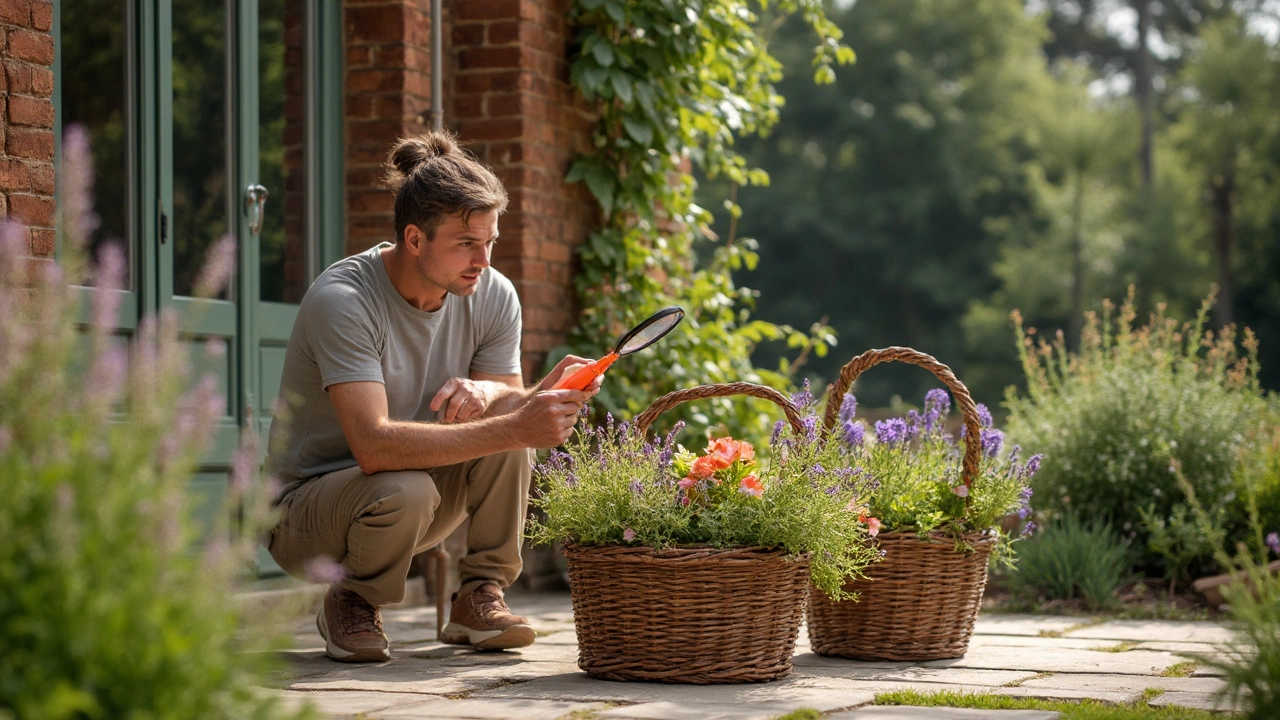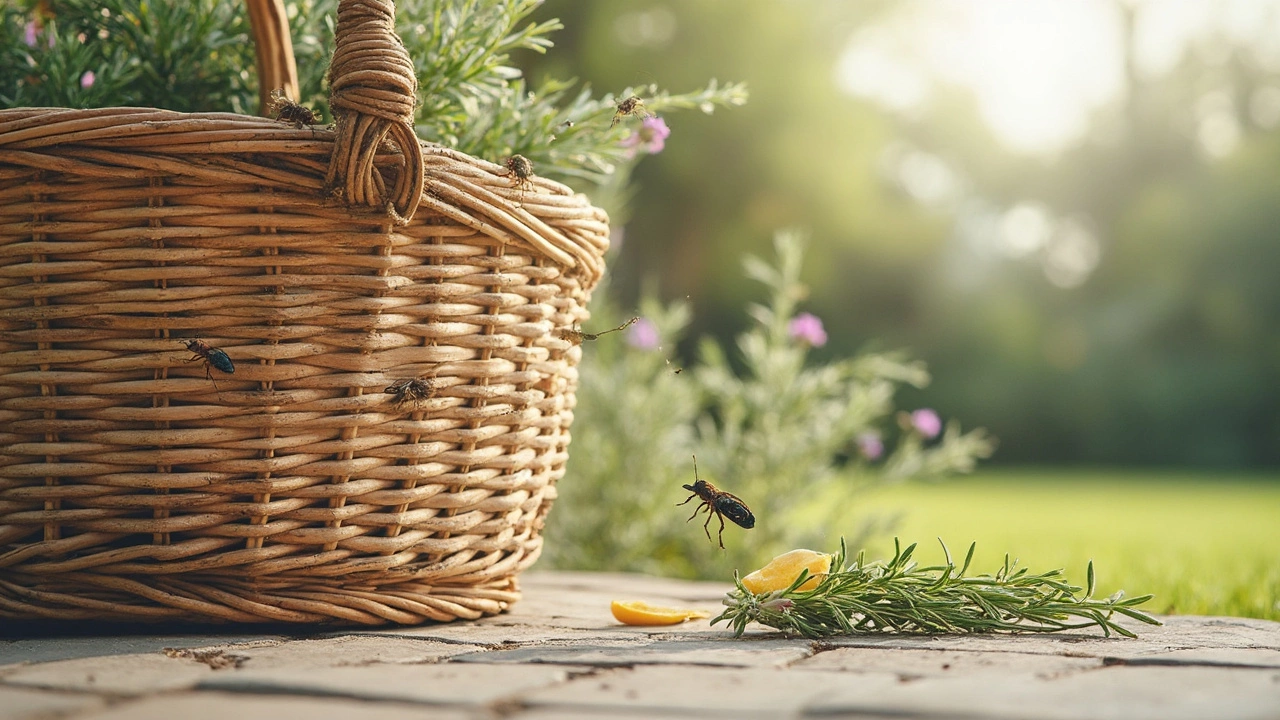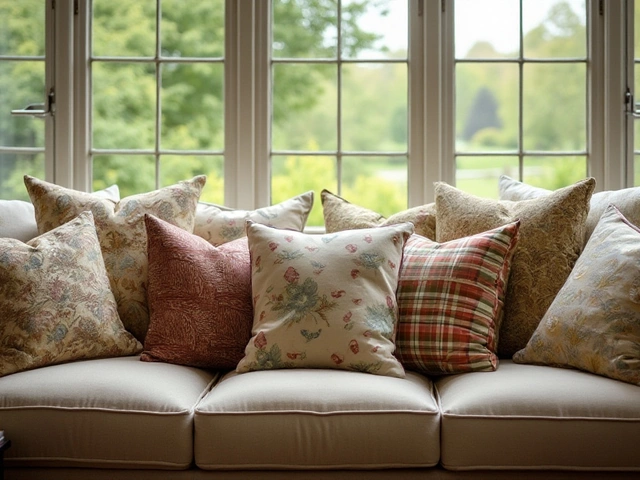 2
May,2025
2
May,2025
If you’re setting up wicker baskets outside, you’re probably worrying about bugs moving in. This is a real thing—anyone with outdoor furniture has seen something crawling around sooner or later. Bugs are drawn to certain materials and spots, and wicker isn’t just pretty, it sometimes checks all their boxes too.
Real wicker comes from natural materials like rattan or willow, which naturally attract insects looking for moisture or a cozy spot to hide. But it’s not just what the basket’s made from. Humidity, leftover crumbs, and dampness are magnets for tiny visitors. Even synthetic wicker is not off the hook if it’s dirty or collects debris. The good news? You don’t have to give up your baskets—just knowing what makes them attractive to bugs is the first step in keeping pests away.
- What Makes Wicker Appealing to Bugs?
- Real vs. Synthetic Wicker: Does it Matter?
- Common Bugs Found in Wicker Furniture
- Ways to Prevent Bug Infestations
- Cleaning and Maintenance Tips
What Makes Wicker Appealing to Bugs?
Bugs love hiding out in places that give them shelter, warmth, and handy access to food or water. That’s why wicker baskets can become a prime hangout—especially the ones made from natural stuff like rattan, bamboo, or willow. These materials hold tiny pockets of moisture and, over time, can pick up little food crumbs or plant bits that catch the attention of ants, beetles, and even termites. Some bugs even chew on natural fibers.
Wicker isn’t a solid sheet—it's all those woven gaps and crevices that make the design awesome but are basically bug motels. In warm or humid weather, those gaps help trap moisture, which sends a big welcome sign to pests like silverfish and earwigs. Even worse, if the garden furniture sits close to plants or on grass, bugs have an easy highway straight to your baskets.
Take a look at how specific bug magnets stack up:
- Moisture: Humid environments create perfect conditions for bugs that love dampness, like mold mites or cockroaches.
- Organic Material: Food bits, fallen leaves, or dirt caught in the weave invite ants, beetles, and other hungry pests.
- Gaps and Shadows: The shade and tight spaces give bugs like spiders and earwigs places to hide out of sight.
Here’s a quick comparison of risk factors for attracting bugs in real vs. synthetic wicker:
| Factor | Real Wicker | Synthetic Wicker |
|---|---|---|
| Absorbs Moisture | Yes | No |
| Organic Smell | Yes | No |
| Attracts Chewing Insects | Yes | Rarely |
| Harbors Food Bits | Yes | Yes |
Bottom line—anything that keeps your wicker baskets damp or dirty is a dinner invitation for bugs. Keep dry and clean, and you’re making your garden furniture way less interesting to pests.
Real vs. Synthetic Wicker: Does it Matter?
The type of wicker in your garden matters more than most people think. There’s a big difference between old-school natural wicker and newer synthetic kinds when it comes to bugs. Real wicker, made from stuff like rattan, reed, or willow, is basically plant material—just what some bugs crave. They’ll chew on it, burrow inside, and even snack on leftover crumbs that might get stuck in the weave. This is the main reason why wicker baskets made from natural sources need extra attention in outdoor spaces.
Synthetic wicker is usually made from plastics like resin or PVC. Bugs can’t eat this stuff and they don’t get much out of moving in—except maybe a hiding place now and then. There’s nothing tasty or soft to nest in, which makes synthetic wicker a better pick if you’re worried about pests. Plus, synthetic options usually handle rain and sun a lot better, cutting down on dampness, mold, and rot—conditions most bugs love.
If you’re still deciding between real and synthetic wicker, here are some things to consider to keep your garden furniture bug-free:
- Durability: Synthetic materials last longer and need less maintenance. Real wicker can weaken over time, giving bugs easy access.
- Moisture resistance: Resin-based wicker won’t soak up water, so bugs like termites and mold have nowhere to settle.
- Cleaning: Both types collect dirt, but synthetic is way easier to wipe down and keep tidy, which helps reduce bugs.
- Appearance: Modern synthetic wicker looks almost just like the real thing, so most people won’t even notice the difference in style.
Check out this quick comparison:
| Feature | Real Wicker | Synthetic Wicker |
|---|---|---|
| Bug Attraction | High | Low |
| Moisture Resistance | Low | High |
| Durability Outdoors | Medium | High |
| Maintenance Needed | Frequent | Minimal |
If bugs are your main concern, synthetic wicker makes life a lot easier. But even with real wicker, a little extra care goes a long way—just expect to put in more work to keep those wicker baskets clean and bug-free.

Common Bugs Found in Wicker Furniture
If you’ve ever flipped over your wicker baskets and spotted something scurrying, you’re not alone. Certain bugs love the nooks and crannies of wicker, especially when those baskets live outside as garden furniture. Here’s a rundown of the main culprits:
- Ants: These guys are always on the hunt for food scraps. If you use your wicker for picnics or storage, you’re basically sending out dinner invitations to ants. They’ll set up shop quickly if you don’t keep the area clean.
- Spiders: Wicker’s tiny gaps are spider real estate. They spin webs between the weaves, hoping to catch other small bugs. While not always harmful, their webs (and the occasional spider surprise) aren’t exactly what you want on your patio.
- Termites: Now, this is the biggie for wicker baskets made from real wood or rattan. Termites eat away at the actual material and can destroy a basket from the inside out. They’re more likely where it’s humid or where baskets rest on damp surfaces.
- Beetles: Wood-boring beetles will lay eggs in wicker made from untreated natural materials. Their larvae chew through the fibers as they grow, causing serious internal damage over time.
- Silverfish: These tiny, silvery bugs like dark, damp corners. Wicker baskets, especially ones with plenty of shade and a little moisture, seem like paradise to them.
If you’re seeing droppings, small holes, or piles of sawdust around your outdoor wicker baskets, you’ve got bugs. To give you an idea of which bugs you might spot most often and why, check out this simple breakdown:
| Bug | What Attracts Them | Signs of Infestation |
|---|---|---|
| Ants | Food crumbs, sticky spills | Visible lines of ants, tiny eggs |
| Termites | Moist wood, mulch under baskets | Hollow sounds, piles of sawdust |
| Beetles | Untreated/aged wicker | Small round entry holes |
| Silverfish | Humidity, dark corners | Shed skins, yellow stains |
| Spiders | Other bugs, quiet hiding spots | Webs between weaves |
Knowing which bugs you’re up against helps you spot a problem before it wrecks your garden furniture. It’s not just about the gross factor—some of these bugs can do real damage if you ignore them.
Ways to Prevent Bug Infestations
You don’t have to ditch your wicker baskets just because of bugs. A few basic habits will keep bugs at bay and your garden furniture looking fresh. Here’s what works best:
- Keep it dry: Most bugs love moisture. Always place your baskets where they can air out, and never leave them in damp corners after rain. Bring them inside if you know there’s a storm coming.
- Clean up crumbs: Treat baskets as you would your kitchen counter. Shake out debris and regularly vacuum or brush inside and out. Food scraps and sticky spills are like an open invitation to ants and other insects.
- Seal and protect: Use a clear furniture spray or even diluted vinegar to wipe down baskets every month. This helps repel some common bugs. Just check your basket’s label to make sure sprays won’t damage the finish.
- Check for nests: Take a look inside your baskets every now and then. Spiders, beetles, and wasps might try to move in, especially in shaded spots.
- Use liners or covers: If you’re using baskets for storage, line them with fabric or a plastic liner. This makes it harder for bugs to squeeze in or lay eggs.
- Choose placement wisely: Don’t put wicker right on the ground or in thick grass. Bugs like hiding spots, and high-traffic areas get fewer uninvited guests.
A quick cleanup after each garden hangout saves you headaches later on. Did you know in a study of outdoor living spaces, baskets that stayed wet for more than a day were 70% more likely to attract ants? Keeping things dry really matters.
| Prevention Step | Bug Risk Reduced |
|---|---|
| Regular Cleaning | Ants, Roaches, Spiders |
| Dry Storage | Termites, Beetles |
| Using Liners | Moths, Beetles |
| Outdoor Spray | Ants, Spiders |
Baskets don’t have to be bug hotels. If you make a routine out of checking and cleaning, you’ll avoid most infestations, and your outdoor setup will stay inviting for people, not pests.

Cleaning and Maintenance Tips
Keeping your wicker baskets and garden furniture bug-free comes down to regular cleaning and smart habits. Bugs love hidden crumbs, moisture, and dust. So, your best move? Don’t give them a reason to stick around.
Start by dusting wicker with a dry brush or a vacuum using the brush attachment. That knocks out spider webs and dirt trapped in the gaps. Every month or so, give your baskets a deeper clean:
- Mix a few drops of mild dish soap in a bucket of warm water.
- Dip a soft cloth or a small brush in the solution and gently scrub the wicker. Don’t soak it—a wet basket only attracts more bugs.
- Rinse with a barely damp cloth to get rid of soapy residue.
- Set your baskets in the sun for a few hours to dry. Sunlight helps kill bacteria and discourages mold and bugs.
Want to up your game? Consider spraying your baskets with a vinegar-water mix (equal parts) every few months. Vinegar's not a fan favorite with bugs and gives an extra layer of protection. Just make sure to spot-test first so you don’t stain the material.
If your baskets are outdoors all the time, try not to leave them on damp soil or wet grass. Elevate them on a shelf or a patio table—anywhere that stays dry and allows airflow underneath. Moisture under the basket is the perfect setup for critters.
Here's a quick look at how often you might want to handle basic maintenance:
| Task | How Often |
|---|---|
| Dusting | Weekly |
| Deep Cleaning | Monthly |
| Inspect for Bugs | Bi-weekly |
| Sun-drying | As needed after cleaning |
For bonus points, store wicker baskets indoors during the rainy season or at least cover them up. Covers don’t just keep the rain out—they block dust and the curious bugs too. Stick to these basics, and your outdoor decor will look good and stay pest-free all year.




